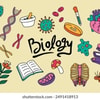Grade 9 Past Paper Practice: Biological Molecules (Reducing Sugar)
Document Details

Uploaded by PinkCoffee
Tags
Summary
This document contains practice questions about detecting reducing sugars using Benedict's solution, including details on testing methods and safety precautions. The questions cover aspects of biological molecules, specifically the test procedure.
Full Transcript
**Grade 9 Topic: Biological molecules Subtopic: Test for reducing sugar (Benedict test )** **Past paper practice question.** 1\. Glucose is a reducing sugar. Benedict's solution is used to test for the presence of reducing sugar. (a) Describe how you would use Benedict's solution to test for reduc...
**Grade 9 Topic: Biological molecules Subtopic: Test for reducing sugar (Benedict test )** **Past paper practice question.** 1\. Glucose is a reducing sugar. Benedict's solution is used to test for the presence of reducing sugar. (a) Describe how you would use Benedict's solution to test for reducing sugar in a piece of potato. Include details of a safety precaution in your answer. \...\...\...\...\...\...\...\...\...\...\...\...\...\...\...\...\...\...\...\...\...\...\...\...\...\...\...\...\...\...\...\...\...\...\...\...\...\...\...\...\...\...\...\...\...\...\...\...\... \...\...\...\...\...\...\...\...\...\...\...\...\...\...\...\...\...\...\...\...\...\...\...\...\...\...\...\...\...\...\...\...\...\...\...\...\...\...\...\...\...\...\...\...\...\...\...\...\... \...\...\...\...\...\...\...\...\...\...\...\...\...\...\...\...\...\...\...\...\...\...\...\...\...\...\...\...\...\...\...\...\...\...\...\...\...\...\...\...\...\...\...\...\...\...\...\...\... \...\...\...\...\...\...\...\...\...\...\...\...\...\...\...\...\...\...\...\...\...\...\...\...\...\...\...\...\...\...\...\...\...\...\...\...\...\...\...\...\...\...\...\...\...\...\...\...\... \...\...\...\...\...\...\...\...\...\...\...\...\...\...\...\...\...\...\...\...\...\...\...\...\...\...\...\...\...\...\...\...\...\...\...\...\...\...\...\...\...\...\...\...\...\...\.....\[3\] Some students were given a 1.0% glucose solution and some distilled water. They diluted the glucose solution to produce five solutions of different concentrations. The students tested each of the solutions they had prepared with Benedict's solution. The concentrations of the solutions and the results of their tests are shown in Table 1.1. The students also decided to test the distilled water with Benedict's solution. (b) (i) Write the result of this test in Table 1.1. \[1\] \(ii) Explain why the students tested the distilled water. \...\...\...\...\...\...\...\...\...\...\...\...\...\...\...\...\...\...\...\...\...\...\...\...\...\...\...\...\...\...\...\...\...\...\...\...\...\...\...\...\...\...\...\...\...\.... \...\...\...\...\...\...\...\...\...\...\...\...\...\...\...\...\...\...\...\...\...\...\...\...\...\...\...\...\...\...\...\...\...\...\...\...\...\...\...\...\...\...\...\...\...\[1\] \(c) The students compared the colour of their solutions after the same length of time. State three other variables that the students should have controlled to make their results comparable. 1 \...\...\...\...\...\...\...\...\...\...\...\...\...\...\...\...\...\...\...\...\...\...\...\...\...\...\...\...\...\...\...\...\...\...\...\...\...\...\...\...\...\...\...\...\...\...\...\... 2 \...\...\...\...\...\...\...\...\...\...\...\...\...\...\...\...\...\...\...\...\...\...\...\...\...\...\...\...\...\...\...\...\...\...\...\...\...\...\...\...\...\...\...\...\...\...\...\... 3 \...\...\...\...\...\...\...\...\...\...\...\...\...\...\...\...\...\...\...\...\...\...\...\...\...\...\...\...\...\...\...\...\...\...\...\...\...\...\...\...\...\...\...\...\...\...\...\... \[3\] The students were then provided with a glucose solution X of unknown concentration which they tested with Benedict's solution. The result was a yellowish-orange colour. (d) (i) Use Table 1.1 to suggest what the students may have concluded about the % concentration of glucose in solution X. \...\...\...\...\...\...\...\...\...\...\...\...\...\...\...\...\...\...\...\...\...\...\...\...\...\...\...\...\...\...\...\...\...\...\...\...\...\...\...\...\...\...\...\...\...\.... \...\...\...\...\...\...\...\...\...\...\...\...\...\...\...\...\...\...\...\...\...\...\...\...\...\...\...\...\...\...\...\...\...\...\...\...\...\...\...\...\...\...\...\...\...\[1\] **Biological Molecules: Benedict\'s Test for Reducing Sugar** The Benedict\'s test is a simple biochemical reaction to detect reducing sugars such as glucose. When reducing sugars are present, the Benedict's solution changes color, indicating their concentration in the sample. This test is commonly used in laboratory experiments to identify the presence of glucose and other reducing sugars. **Fill in the Blank**: Fill in the blank with the correct words. 1. The Benedict\'s test is used to identify ***\_\_*** sugars. 2. When glucose is present, Benedict\'s solution changes from blue to ***\_\_***. 3. To perform the Benedict\'s test, you need to heat the solution at ***\_\_*** degrees Celsius. 4. A ***\_\_*** color indicates a high concentration of reducing sugar. 5. Safety precaution: Always wear ***\_\_*** when handling chemicals. **Word bank**: orange, reducing, goggles, 80, red **Multiple Choice Questions**: Choose the correct answer from the choices for each question. 1. What is the initial color of Benedict\'s solution before testing? - a\) Red - b\) Blue - c\) Green - d\) Yellow 2. Why is distilled water used in the experiment as a control? - a\) To dilute the glucose - b\) To provide a sample with no reducing sugar - c\) To show the presence of reducing sugar - d\) To change the color of Benedict\'s solution 3. Which of the following is NOT a variable to be controlled in the Benedict\'s test? - a\) Temperature - b\) Amount of Benedict's solution - c\) Concentration of glucose - d\) Brand of beaker 4. What color indicates a low concentration of glucose in the Benedict\'s test? - a\) Blue - b\) Yellow - c\) Red - d\) Green 5. What type of sugar can Benedict\'s solution detect? - a\) Non-reducing sugar - b\) Reducing sugar - c\) Polysaccharides - d\) Lipids **Open Ended Questions**: Answer the following questions in complete sentences: 1. Describe the steps needed to perform the Benedict\'s test on a piece of potato. 2. Explain why it is important to control variables in a scientific experiment. 3. Suggest a reason why the result of the test with solution X was a yellowish-orange color. **Answer Key**: **Fill in the Blank**: 1. reducing 2. orange 3. 80 4. red 5. goggles **Multiple Choice Questions**: 1. b\) Blue 2. b\) To provide a sample with no reducing sugar 3. d\) Brand of beaker 4. b\) Yellow 5. b\) Reducing sugar **Open Ended Questions**: 1. To perform the Benedict\'s test on a piece of potato, first, crush the potato and mix it with a small amount of water to extract its juice. Add a few drops of the juice to a test tube, then add Benedict\'s solution. Heat the mixture in a water bath at approximately 80°C for a few minutes. Observe any color change. 2. It is important to control variables in a scientific experiment to ensure that the results are reliable and that any changes in the dependent variable are due to the manipulation of the independent variable, not other factors. 3. The yellowish-orange color observed in solution X suggests that the concentration of glucose is moderate, as the color change is typical of a medium concentration of reducing sugars when tested with Benedict\'s solution. Teachers should review the answer key to ensure accuracy, especially in scientific contexts.